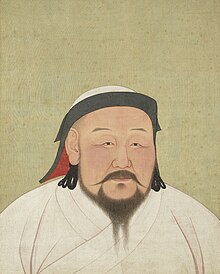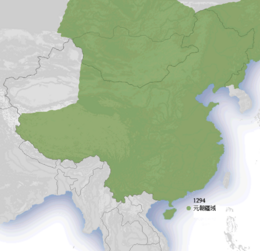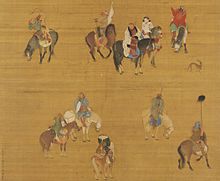Yuan Dynasty
Yuan Dynasty ( Chinese 元朝 , Pinyin Yuáncháo , W.-G. Yüan Ch'ao ) is the Chinese name of the Mongolian imperial family that ruled China from 1279 to 1368 ( Mong. Dai Ön Yeke Mongghul Ulus ).
Consolidation of rule
The dynasty was proclaimed in 1271 by Genghis Khan's grandson, Kublai Khan . Translated, Yuan means "original beginning". It replaced the Song Dynasty after Hangzhou's surrender in 1276 and the defeat of the last Song fans in 1279 . Its capital has been Beijing since 1264 , at that time Dadu ( Tatu ) ( Chinese 大都 , Pinyin Dàdū - "great capital") or, called by the Mongols, Khan-balyq ( Kambaluc , the city of the great Khan). The cities of Shangdu (the Xanadu of poetry) as the summer residence and the city of Karakorum gave legitimacy to the rule.
In terms of domestic and foreign policy, the Yuan dynasty was only formally recognized. There were repeated confrontations with the Mongols who had remained in the steppe (the last one in 1360). In addition, the Mongol rulers in the west, the Golden Horde and the Ilkhan , pursued their own policies from 1260 and 1295 and adopted Islam . The Mongol Empire was divided , around 1310 the previously unstable Chagatai Khanate was reorganized, so that in the 14th century four independent empires were distinguished. Their common interests became more and more subordinate to the individual interests, although the Yuan dynasty held the office of Khaghan (Great Khan) and thus a priority over the other three kingdoms - but this had practically no effects.
The Mongol garrisons were particularly concentrated around the capital, while in the rich areas on the Yangtze ( Yangzhou , Nanjing , Hangzhou ) Chinese troops under Mongol commanders very soon tried to keep the peace. The Chinese soldiers were replaced every two years and relocated to a distant province. Their officers were also regularly transferred to avoid rebellions.
With the Mongol rule, China became part of a world empire for the first time in its history that stretched from Russia to the Far East. Apparently, however, Kublai viewed China as the centerpiece of his empire and his government followed Chinese rather than Mongolian traditions. In this sense, the relocation of the capital to Beijing can also be understood as a departure from the steppe.
Since the Mongols were nomadic cattle breeders, they quickly became minorities in their now dominated territory, as they had to look after their many grazing animals with a few people on sometimes changing and very large areas. This meant that they had to rely on members of foreign peoples to secure their claims to rule. This is also one of the reasons for the intensification of cultural exchanges between the East and the West that took place during the Yuan Dynasty. Iran in particular played an important mediating role.
Population and division of the population

The population of China officially numbered 60 million southern Chinese, 10 million northern Chinese and 2 million Mongols and Semu around 1290. An earlier census of 1235 showed 8.5 million people in northern China, including the enormous numbers of the homeless and enslaved. Compared to the time of the Jin Dynasty , northern China experienced a dramatic population decline.
Before his death, Kublai had the population of China divided into four groups and this was written into the Yuan-dian-zhang code, even if it was a difficult division to keep in practice.
The highest group was made up of the so-called "White Mongols" (real Mongols) who were divided into 72 tribal groups. They alone were allowed to occupy the highest posts in the empire. The "Black Mongols" (Semu) were the people who supported the Mongols in conquering China. These included various Turkic peoples or the Turko-Tatars , but also resettled Alans and Russians . The Black Mongols were allowed to trade, raise taxes, lend money and occupy the middle levels of officials.
The third group was made up of the northern Chinese, called Han-ren . This also included Kitan , Jurchen , Koreans . They were allowed to run a small business and occupy the lower official posts, but not higher officer posts.
The southern Chinese ( Nan-ren ) formed the fourth and most unlawful group. They were not even allowed to defend themselves against beatings and had to bear most of the taxes. However, the Mongols were careful not to confiscate private property in southern China and thus achieved the neutrality of the rich southern Chinese. Instead, they confiscated the land nationalized under Song Chancellor Jia Sidao , which did not improve the situation for ordinary farmers. The Chinese were not allowed to own weapons or horses, changing occupations and marriages between groups were forbidden.
Commerce and Administration
Regardless of the stagnation (compared to previous dynasties), the Mongol rule over China led to an upswing in transit trade and worldwide cultural exchange and knowledge transfer. Examples of the latter are the (unsuccessful) attempt to introduce paper money in Iran in 1293, the rise of Islam in China ( Yunnan , Gansu ), the Christian missions (1307 Archbishopric in Beijing ), a calendar reform under Guo Shoujing based on Persian knowledge, the Chain pump for irrigation in Turkestan , the book Marco Polos ( Il Milione ) and much more.
In contrast to the Confucian officials, the Mongols valued trade and traders (mostly Muslims , organized in guilds) highly, provided them with venture capital and entrusted them with financial matters. The latter had negative effects, as the Muslims tended to tighten the tax screw more than the Chinese. Abd al-Rahman had doubled taxes as early as 1239, while the Finance Minister Ahmad Fanakati , murdered in 1282, had tripled them in three years.
In the interests of domestic trade and the supply of northern China, the northern section of the Imperial Canal was built in 1279–1294 . It was a changed route because the old one was too long and no longer navigable. At the same time, the sea route was used to transport the riches north.
The Mongols divided the administration into the Secret State Council for Military Affairs, the Censorate for the Imperial Supervision of Officials and the Central Secretariat for All Civil Affairs. The latter was divided into the six areas of taxes, personnel, rites, war, justice and public works. However, some provinces were relatively independent (Gansu, Yunnan). Power struggles at the top of the administration were typical. Several, mostly ruthless, ministers paid with their lives (Ahmed Fanakati 1282, Lu Shirong 1285, Senge 1291, Bayan 1340, Toghta 1356). Others died of natural causes (Temüder 1322, El / Yang Temür 1333).
A major problem with Mongol rule in China was the scrutiny of state officials. This had been common in China since the Tang Dynasty and was an important means of legitimation for every dynasty. The Mongols had carried it out in 1237/1238 on the advice of Yelü Chucai and abolished it immediately. It was not until 1315 that Emperor Ayurparibatra had them reintroduced. However, only half of the North and South Chinese were admitted, so that the Mongols still occupied around a third of all posts.
Genghis Khan had already enacted a much-praised canon of law, and the innovative legal practice of the Mongol dynasty as a whole continued to be important and momentous for what would later become China.
Downfall
In the middle of the 14th century there was a series of floods that broke the dams of the Yellow River (1351). The Mongols under Chancellor Toghta had a new canal built south of the Shandong Peninsula. The Chinese succeeded for the first time in organizing the insurgents. Shortly afterwards, several uprisings broke out in central China under various leaders (1352), the most important group being the Red Turbans . Between 1355 and 1368, Zhu Yuanzhang prevailed over his rivals as the future emperor of the Ming dynasty . In 1363 he decided the naval battle on Lake Poyang against the "Han" prince Chen Youliang , in 1368 his army under Xu Da drove the Khan Toghan Timur out of Beijing. This ended the Mongol rule in China.
However, the fall of the Yuan dynasty also had other reasons: In particular, the inability to administer the empire on a permanent basis was a major factor. Another reason that contributed to the downfall was the disruption of the long-distance trading system by an outbreak of the plague in the second third of the 14th century. In contrast to other peoples who had ruled parts of China, the Mongols represented a significant power factor even after the fall of their dynasty, which forced the subsequent Ming dynasty in northern China to grapple with the Mongols. Integration measures and bureaucratic initiatives that began under the Yuan Dynasty were continued by the Ming emperors.
See also
- Emperor of the Yuan Dynasty (or Khans of the Mongols)
- List of the greatest empires and empires
literature
- Timothy Brook: The Troubled Empire. China in the Yuan and Ming Dynasties. Belknap Press of Harvard University Press, Cambridge (Mass.) 2010, ISBN 9780674072534 (English).
- Arthur Cotterell: The Imperial Capitals of China - An Inside View of the Celestial Empire . Pimlico, London 2007, ISBN 978-1-84595-009-5 (English).
- Frederick W. Mote: Imperial China 900-1800. HUP, Cambridge (Mass.) 1999.
- Ann Paludan: Chronicle of the China Emperors . Thames & Hudson, London 1998, ISBN 0-500-05090-2 (English).
- Helwig Schmidt-Glintzer: Small history of China . CH Beck, Munich 2008, ISBN 978-3-406-57066-7 .

